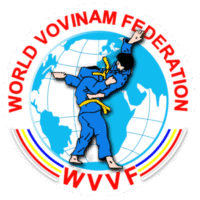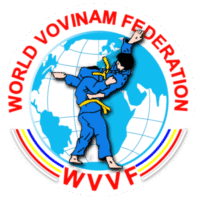The Vovinam – Viet Vo Dao sect was created by the late Master Nguyen Loc in Hanoi, Vietnam. He was born on May 24, 1912, originally from Huu Bang village, Thach That district, Son Tay province (now in Hanoi, Vietnam).
Since childhood, Mr. Nguyen Loc has been passionate about practicing martial arts and traditional wrestling. Growing up in the tragedy of his country being occupied by the French colonialists, he had the desire to use martial arts to contribute to buuilding a generation of young people with patriotism, strong will, good health and the ability to defend themselves. Therefore, in addition to cultivating culture, he also researched many other martial arts to form a new martial art suitable for the constitution of Vietnamese people (slender but quick and flexible) and named it Vovinam. After his research was completed in the fall of 1938, he gave experimental training to a number of friends. Almost a year later, he introduced this class of disciples to the masses at the Hanoi Opera House. The demonstration was a great success and the first public Vovinam class opened at Hanoi Pedagogical School in the spring of 1940. Since then, many martial arts classes have continuously been opened in Hanoi and several neighboring provinces such as Nam Dinh, Son Tay, Thanh Hoa…
The training program during this period was divided into three levels (beginner, intermediate, college) focusing on all three contents (martial arts, martial force, martial religion), but few people studied for more than three years, partly because of the times, partly because he is busy studying and making a living. Since the 50s, Vovinam has been popular in Saigon, Gia Dinh, Bien Hoa and Da Lat. But the work had just begun and was still full of difficulties when Mr. Nguyen Loc passed away on April 29, 1960 (at the age of 49) in Saigon (now Ho Chi Minh City, Vietnam), after handing over the position of Grand Master to the head disciple, Master Le Sang. Currently, the remains of the late Master Nguyen Loc are being preserved at 31 Su Van Hanh Street, District 10, Ho Chi Minh City, Vietnam.
 |
| Founder Nguyen Loc (standing in the middle) with his disciples: Nguyen Van Thong, Tran Duc Hop, Le Sang, Bui Thien Nghia, Nguyen Van Hach, Nguyen Dan (Saigon, 1955). – Photo archive. |
Inheriting the ideas of the late Master Nguyen Loc, Grand Master Le Sang and Master Tran Huy Phong, Nguyen Van Thu, Manh Hoang,… have reorganized the apparatus, training program, examination, and class more scientific and modern. However, because the Republic of Vietnam regime restricted the activities of martial arts sects, in the period from 1961 to 1963, Vovinam only taught at a few private high schools such as: Chan Phuoc Liem, St. Thomas, and in 1964 Vovinam restored it. Thanks to that, the movement gradually developed strongly in most southern provinces. Since the training class was opened in schools (around 1966), the name Vovinam was added to Vovinam-Viet Vo Dao so that young people can focus on the national spirit when practicing martial arts to perfect themselves with three aspects: Heart, Mind, Body to serve the nation and humanity. And following in the footsteps of international students, Vovinam appeared in a number of European countries since 1973. Due to the country’s circumstances, after a year of lull, a number of martial arts masters and coaches gathered and practiced in 8 District, Ho Chi Minh City, then performed in several other places…
On December 15, 1978, the Vovinam-Viet Vo Dao class officially opened at Hoa Binh swimming pool, 8 District led by Master Nguyen Van Chieu, starting the process of restoring the sect in the Ho Chi Minh city. And from this time until the mid-80s, a number of martial arts masters in provinces such as Can Tho, Vinh Long, Khanh Hoa, Binh Dinh, Phu Yen… also asked for permission to open training classes. In June 1980, Vovinam-Viet Vo Dao was invited to attend the Martial Arts Festival organized by the Institute of Educational Sciences and Central College of Physical Education 2 in Ho Chi Minh City; Training for the Southern Martial Arts Research Class of the Police Department of the Ministry of Internal Affairs (4 month intensive course – 1985). In 1989, the Ho Chi Minh City Viet Vo Dao Association under the Ho Chi Minh City Martial Arts Federation was established. This is a notable event because it affects the expertise, personnel and interest of other provinces and cities with the Vovinam sect. With the recovery of the movement and the efforts of Masters Tran Huy Phong and Nguyen Van Chieu in sportizing the discipline, Vovinam was General Department of Physical Training and Sports (now the Committee for Physical Training and Sports) included in the Region III Technical Demonstration Program (1990). Also in this year, 4 martial arts masters from Ho Chi Minh City (Nguyen Van Chieu, Le Thanh Liem, To Manh Hoa, Nguyen Anh Dung) were invited to Belarus to perform, and at the same time sent people to stay for training.
In order to create conditions for Vovinam-Viet Vo Dao to develop, the sports industry of provinces and cities and the General Department of Sports and Physical Training have organized championships at provincial, city and national levels since 1992. A few years later, there were also championships at the provincial, city and national levels. Added Regional prizes, Youth prizes, Children’s Youth prizes, Hoi Khoe Phu Dong prizes, international prizes… Competition content includes: Technical demonstration and individual competition. Through 10 national championships, the number of participating delegations is increasing, and the level of athletes is improving; In particular, since 1997, athletes who have achieved high results at the national championship have been awarded the rank of grandmaster by the Sports Committee like other sports. Strong units in the national tournament during that period were: Ho Chi Minh City, Khanh Hoa, Can Tho, Ba Ria-Vung Tau, Dong Nai, the Army. In the field of management and expertise, the General Department of Sports and Sports established the Vovinam-Viet Vo Dao Executive Board in April 1995. Every year, the Executive Board organizes professional conferences for martial arts masters to review and unify the training program, gradually complete the rules of fighting competitions, technical exhibition rules, refereeing skills, compilation technical books, unified videos national performances. At the same time, three training courses to train Vovinam instructors in Thanh Hoa, Ha Tay, and Quang Binh provinces for the Northern provinces have created conditions for this region to build the subject and gradually integrate into the movement. As of December 2001, Vovinam gathered about 30,000 students regularly practicing in most southern provinces and some northern provinces. On the international level, martial artists from Ho Chi Minh City, Ba Ria-Vung Tau, the Army… have been sent by the sports industry to attend many international traditional martial arts festivals in Thailand, Germany, Korea, Japan. Vovinam’s attractive and artistic performances have contributed to helping friends from all over the world understand more about the country and people of Vietnam, receiving warm applause from viewers and the interest of the world’s martial arts world. Master Nguyen Van Chieu was invited to train in France, Spain, Italy, and Germany. Some countries have opened Vovinam classes such as France, Spain, Germany, Italy, Switzerland, Romania, Poland, Belgium, Morocco, Algeria, Belarus…; Among them, the Vovinam movement in France, Spain, Italy… developed quite well.
With the spirit of “Drinking water, remember the source”, many groups of foreign martial arts students have returned to the ancestral land to visit the late Founding Master of the Sect, greet the Grand Master, receive technical training, take belt promotion exams or attend conferences International Vovinam-Viet Vo Dao show (1998-2001) in Ho Chi Minh City. With initial achievements over the past 25 years, Vovinam-Viet Vo Dao was included in the official competition content by the Vietnam Sports Committee at the 4th National Sports Congress in 2002. This is a process of sacrifice, determination to overcome difficulties of the collective of martial arts masters, coaches and martial arts students throughout the country under the leadership of the sports industry. And by 2011, Vovinam officially became a competition for the first time at the 26th SEA Games (in Jakarta, Indonesia), with 14 sets of medals and creating a good impression on the creativity of the katas. Two years later, at the 27th SEA Games in Myanmar, this Vietnamese martial art continued to appear in the list of competitions, even increasing the number of medals to No 18. At that time, it was thought that Vovinam would soon become a familiar sport in Southeast Asian competitions. But then, at three consecutive SEA Games, for different objective reasons, Vovinam was absent. And only in 2022 will Vovinam return to the regional playground when Vietnam is the host of SEA Games 31.
The SEA Games arena is the place that accurately reflects the arduous journey that Vovinam faces when it wants to enter the international playground. The fact that other countries win many medals will be the driving force for Vovinam’s long-term development in their country. Therefore, it is necessary to have a specific strategy to not only continue to promote Vovinam domestically but also develop it with friends in the region in particular and internationally in general, attracting a large number of countries to participate, practice and promote the movement to develop further. From there, it serves as a solid foundation for Vovinam to become a sport that is not only regularly present at the SEA Games, but in the future also at continental and world sports conferences.
Nearly 65 years have passed, from a new sect in Hanoi, Vovinam-Viet Vo Dao has developed and flourished throughout the provinces and cities nationwide. And especially, it has been spread to many other countries around the world; Vovinam-Viet Vo Dao has contributed significantly to the cause of preserving and promoting the national martial arts tradition; becoming a modern, scientific and practical Vietnamese martial art, attracting support from many domestic and international circles. The joint efforts of martial arts masters and each student in all regions are day by day creating a resilient, indomitable, and proud Vietnamese temperament.

